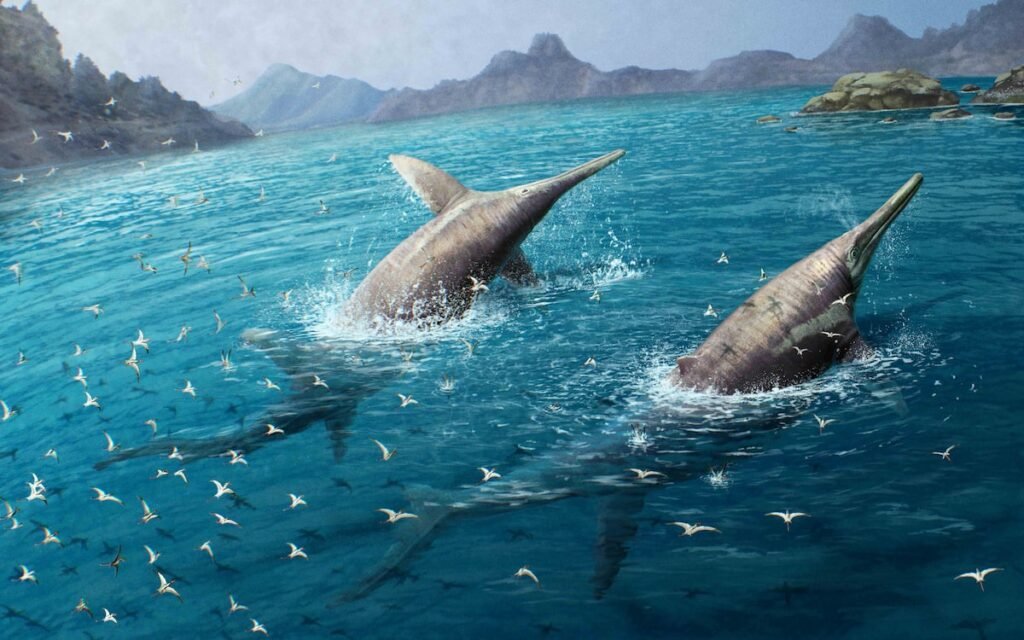This illustration, obtained by Reuters on April 16, 2024, depicts a giant marine reptile newly confirmed to have lived 202 million years ago based on fossils discovered in Somerset, England. A pair of Ichthyotitans severnensis are swimming. Gabriel Uguet/Handout (Reuters)Gabriel Uguet/Reuters
A fossilized jaw discovered by a British girl and her father on the coast of Somerset, England, belongs to a 202-million-year-old giant marine reptile that may have been one of the largest animals to have ever lived on Earth. is.
Researchers announced Wednesday that the bone is called a salangular and belongs to a type of pelagic reptile called an ichthyosaur. The Triassic creature, which researchers named Ichthyotitan severnensis, was between 72 and 85 feet (22 and 26 meters) long, based on its dimensions compared to the same bone in a related ichthyosaur. It was estimated that
That would likely make it the largest known marine reptile, rivaling the largest baleen whale alive today. Considered to be the largest animal ever on Earth, blue whales can reach lengths of around 100 feet (30 meters).
When dinosaurs ruled the land, marine reptiles ruled the world’s oceans. Ichthyosaurs, which evolved from terrestrial ancestors and flourished for about 160 million years before disappearing about 90 million years ago, come in a variety of sizes and shapes and feed on fish, squid relatives, and other marine reptiles. , give birth to live children.
Ichthiotitan is known only from two jaw bones. One was discovered by Ruby Reynolds and his father Justin Reynolds in Blue Anchor, Somerset, in 2020, and another was discovered along the Somerset coast in Lilstock in 2016. It is from an individual of Ichthiotitan.
Dean Lomax, a palaeontologist at the university, said: “During the Triassic period, when dinosaurs walked on land in what is now Britain, we believe that ichthyosaurs the size of giant blue whales were swimming in the sea. is extremely noteworthy.” from the University of Manchester and the University of Bristol, and lead author of the study published in the journal PLOS ONE.
Ruby Reynolds, who was 11 at the time and is now 15, discovered the piece while fossil hunting on the beach with her father. Ruby continued to search the area and discovered a second piece, much larger than the first, partially buried in the muddy slope. They then contacted Lomax, an ichthyosaur expert, and additional bone sections were unearthed.
Ruby Reynolds’ role in this discovery has led to comparisons, among other things, with Mary Anning, a 19th century British fossil hunter and anatomist who discovered an ichthyosaur fossil when she was 12 years old.
“I think Mary Anning was a great paleontologist, and it’s amazing to be compared to her,” Ruby Reynolds said.
“Working with these experts was a wonderful, enlightening and enjoyable experience. We are proud to be part of the team and co-authors of the scientific paper naming the new species and genus. I think so,” Justin Reynolds added.
Fossil collector Paul de La Salle discovered a 2016 fossil that is now attributed to Ichthiotitan.
Ichthiotitan’s enormity was awe-inspiring.
“Discoveries like this create wonderful moments in which we are humbled by our size and place in the world. Animals of this scale once swam our oceans, felt the warmth of the same sun, Knowing that they breathe our air and then disappear gives us an opportunity to see how important each species is to the fragile yet resilient fabric of life. ” said Jimmy Waldron, a Florida-based paleontologist and study co-author.
Ichthyotitan was a member of the giant ichthyosaur family called Shastasauridae, and lived 13 million years later than any other known ichthyosaurs, meaning that these giants lived about 201 million years ago. It has been suggested that they survived the global mass extinction event that was destined to wipe out many species of animals 10,000 years ago. End of the Triassic period.
No fossils of the rest of Ichthyotitan’s skeleton have been found, but researchers have been able to identify its appearance based on other members of Ichthyotitan, such as Shonisaurus from British Columbia, Canada. Ta.
The trigonum is a long, curved bone located at the top of the lower jaw, just behind the teeth, and is present in almost all vertebrates, living or extinct, except mammals. Muscles attached to this bone generate bite force.
“In Tyrannosaurus, the horns are over 0.5 meters (1-1/2 feet) long. The horned body that Ruby and her father found extended over 2 meters. This shows just how huge this animal was. “It shows that there was a big push behind that bite,” said Waldron, who founded the traveling dinosaur museum Dinosaurs Will Always Be Awesome.

